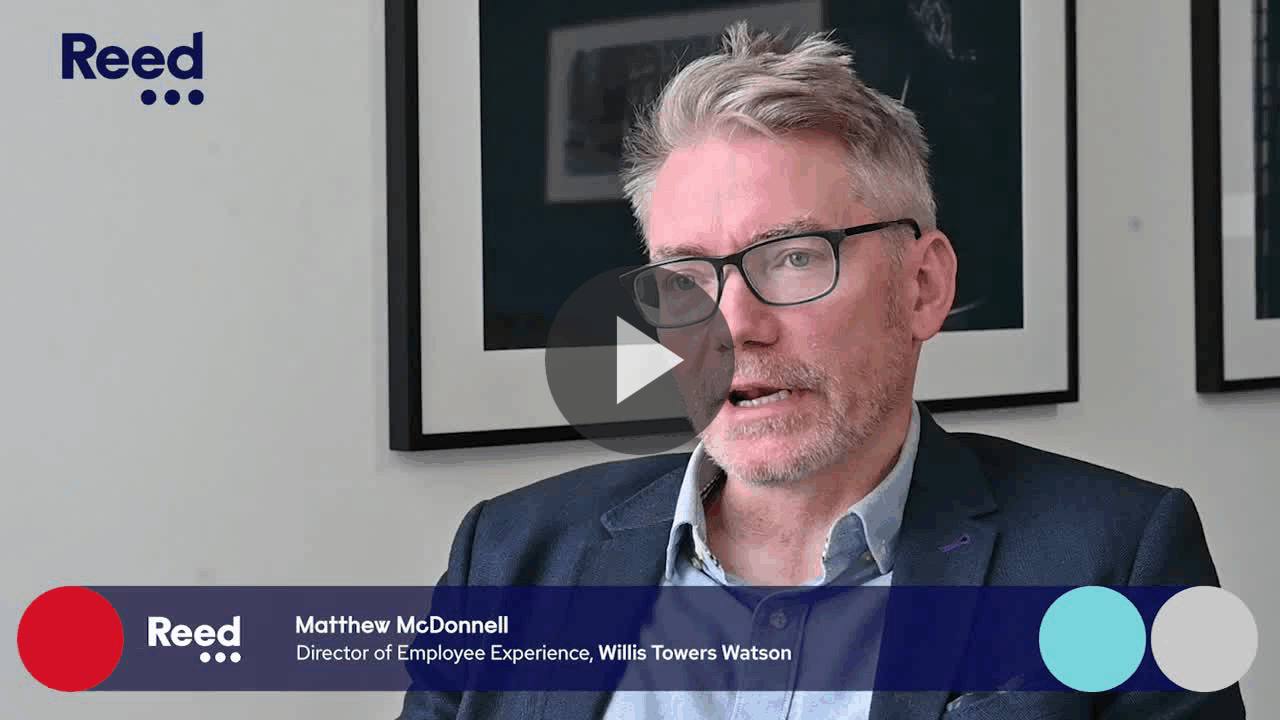How well does your organisation listen to its employees? Satisfaction surveys are a fundamental element of an effective listening strategy, and in order to drive real change across your business, leaders need to better understand what their employees are thinking and work with them to build a culture that motivates and engages its people.
Insurance company, Willis Towers Watson (WTW) supply data-driven, insight-led employee engagement solutions that engage employees, maximise performance, and make organisations more resilient. We spoke to Matthew McDonnell, Director of Employee Experience at WTW, to find out how they use satisfaction surveys, with advice on the best types of questions to ask, how to ensure they are reliable, and what to do with the results.
Watch the full video interview below:

Q: How often should businesses ask staff to fill out employee satisfaction surveys?
A: So, this is a hotly debated topic and you'll find the internet is awash with viewpoints on how frequently people should ask surveys.
I can answer this from a practitioner's point of view - I've been working with organisations for almost 20 years on running their employee engagement surveys. So, what we're seeing is a big shift, and I think a very helpful shift, to continuous listening. This is listening in the moment. Perhaps it's around inclusion, diversity, perhaps it's around something that's happening externally. For example, now we're looking at questions around financial wellbeing. I think these surveys should happen frequently, and you should just be getting a pulse on the organisation, so you can act in real time.
And they don't have to be surveys. We can have virtual focus groups with employees, but the key is that you're listening frequently to employees to understand what's going on in their minds. Having said that, what we find, is most organisations derive a lot of value from one annual census, a broad survey that goes across the organisation, and typically this will follow with the business cycle. Normally it's towards the end of the year where you're looking to meet your targets or KPIs, and you can reflect on how the year has gone from a ‘people’ perspective, and what you need to do moving forward. So, setting that line in the sand is really helpful on an annual basis.
Our recommendation is some kind of annual census survey that goes out to the whole organisation, and pulsing as and when you need it on topical topics for clients.
Q: What types of questions should they include?
A: Typically, we ask closed questions, so statements around the purpose of the organisation to understand what an organisation stands for, what it means, what its mission is, whether I'm [the employee] included in that journey.
Also questions around how do we do our work? Are we bureaucratic, are we efficient, are we agile, customer focused? Are we empowering as an organisation?
We would also ask questions around total reward - and this is not just pay or benefits, but it's also how is my performance managed? Is it fair, is it continuous, is it forward looking, and are we a growth-minded organisation? So those are important. And finally, what are the people like that I work with? So, my managers, my colleagues, my leaders, is it a high-trust environment?
That's a broad set of questions to ask and I would also highly recommend having open-ended questions where they can say what they would do if they were CEO for the day - how would they change the organisation for the better?
So open-ended and closed-ended questions. Normally we'd aim for about 40 questions, which in our estimation takes about seven or eight minutes for an employee to complete.
Q: How can employers ensure the results are reliable and that employees feel they’re able to give honest answers?
A: There’s a couple of factors at play here, so first of all is the maturity of the organisation in terms of doing the surveys - you build trust and confidence in the process over time. But having said that, almost every organisation will have a segment of the population, often very, very small, but can be very vocal, who just do not trust the process.
They don't trust what you're going to do with the data. And I think you just have to accept that - it may be one or two percent, it's a small percentage. But what you need to do if you're doing it for the first time is communicate, and overcommunicate, around the confidentiality of the process. Hopefully you're using an independent provider rather than doing it internally so that you have that objective viewpoint, and really it's around what you do with those results.
So over time, if organisations and people can see that the reason we gave our feedback was so that leaders, teams, and managers would take action, and now we're seeing positive results from that, then it's much clearer to them the purpose of the survey in the first place.
Q: What should companies do with the findings?
A: I can tell you what they certainly shouldn't do, which is to take the results and put them in a drawer and say that we've now done an engagement survey. This is where the work really begins. The results are in and now organisations, leaders, and managers need to step up and communicate to people.
What we're noticing is that there's less patience for organisations to sit on results. People want to hear very, very quickly. We would recommend that leaders and managers are communicating within a week or two to employees around what the survey said. You don't need to have the answers at this point, but you need to highlight what the key findings are and then you need to go back to the organisation and ask them, ‘what do we do about it?’
What we find is leaders trying to solve everything doesn't work as well as involving everybody in the change process and having co-ownership from employees, all the way to the top of the organisation, in terms of implementing new ideas. So, it's leader-supported, but an employee co-owned process, and that takes time.
It may take six months to see real impact based on the survey results but continuing to communicate to employees what you're doing is absolutely critical. They won't make the connection unless you tell them that ‘you said this’, ‘this is what we're doing’ and ‘this is why we're doing it’. And that's how you build the confidence in this process.
Q: How have you helped companies improve their employee satisfaction through the use of surveys?
A: One example springs to mind, which is a client that received the survey results and they realised already that they had lost touch with the sentiment of employees - they knew there was disgruntlement there.
The data came back, and they didn't really understand it, but rather than saying, ‘well, let's make some assumptions here’, they commissioned us to do focus groups on the entire population to make sure that we're covering all different segments, from corporate staff to people working in the fields, agricultural workers, and going to warehouses and running workshops there.
And, what was really noticeable, was people coming into those focus groups unsure of why they were there, what the intent was, and as you went through the process of asking them why they said what they said, what was going well, what could they improve, what specific actions would they recommend, you could feel the room come alive. People were getting excited about it and they could see there was potential for them - wherever they were in the organisation - to have an impact.
So, we took all these results and fed them back to the leaders, then the leaders decided from the list of things which ones they would prioritise. They said why they would prioritise those and they also asked people within the organisation - volunteers - to support them implementing those changes. They established cross-functional, cross-department teams looking at these issues and coming up with solutions.
What we saw when we did the survey again a year later was a sea of green, which is in terms of our survey scores, very, very positive. The dashboards were all lighting up with positive improvements from where they were in the past. So, the way the organisation came together, and the fact they took a co-ownership approach to improving the organisation made them the most satisfying client that I've worked with.
For more information about building a happier, satisfied workforce, download our free eBook today.





